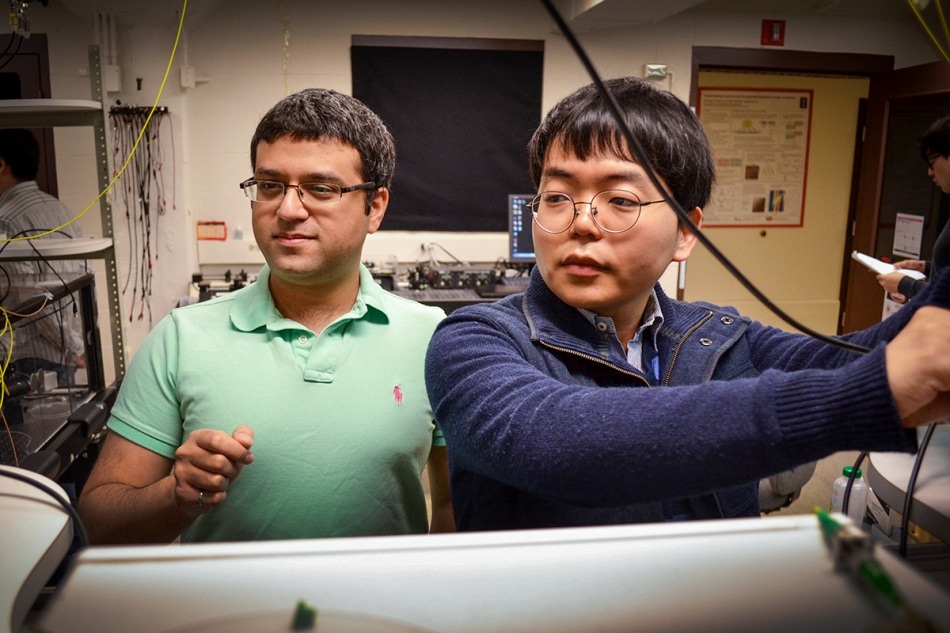Aug 13 2019
A technique for redirecting misfit light waves to minimize energy loss in the process of optical data transmission has been developed by engineers from the University of Illinois.
 Mechanical science and engineering professor Gaurav Bahl, left, and graduate student Seunghwi Kim confirmed that backscattered light waves can be suppressed to reduce data loss in optical communications systems. (Image credit: Julia Stackler)
Mechanical science and engineering professor Gaurav Bahl, left, and graduate student Seunghwi Kim confirmed that backscattered light waves can be suppressed to reduce data loss in optical communications systems. (Image credit: Julia Stackler)
As part of the study, the researchers took advantage of the interaction between light and sound waves to inhibit the scattering of light from defects in materials, which could pave the way for optimized fiber optic communication. The study outcomes have been reported in the journal Optica.
Light waves get scattered upon encountering obstacles such as a tiny defect in a fiber optic cable or a crack in a window. A major portion of the light gets scattered out of the system. However, some portion of the lights gets scattered back to the source through a phenomenon known as backscattering.
There is no such thing as a perfect material. There is always a little bit of imperfection and a little bit of randomness in the materials that we use in any engineered technology. For instance, the most perfect optical fiber used for long-range data transmission might still have some invisible flaws.
Gaurav Bahl, Study Lead Author, Mechanical Science and Engineering Professor, University of Illinois
Bahl continued, “These flaws can be a result of manufacturing, or they can appear over time as a result of thermal and mechanical changes to the material. Ultimately, such flaws set the limits of performance for any optical system.”
In some earlier studies, it has been demonstrated that unwanted backscattering can be suppressed in special materials with specific magnetic properties. Bahl stated that these options are not viable for existing optical systems in which transparent, nonmagnetic materials such as silica glass or silicon are used.
As part of their new study, Bahl and graduate student Seunghwi Kim controlled backscattering by exploiting the interaction of light with sound waves, rather than magnetic fields.
Bahl stated that light waves move at the same speed through a majority of the materials, regardless of the direction, whether forward or backward.
But, by using some direction-sensitive opto-mechanical interactions, we can break that symmetry and effectively shut down backscattering. It is like creating a one-way mirror. By blocking the backward propagation of a light wave, it has nowhere to go when it encounters a scatterer, and no other option than to continue moving forward.
Gaurav Bahl, Study Lead Author, Mechanical Science and Engineering Professor, University of Illinois
The researchers demonstrated this phenomenon by passing light waves through a tiny sphere of silica glass, known as a microresonator. Within the tiny sphere, the light moves along a circular path similar to a racetrack, coming across defects in the silica repeatedly, thus amplifying the backscattering effect.
Then, the researchers engaged the light-sound interaction along only the backward direction by using a second laser beam, thereby eliminating the possibility of backward scattering of light. What would have turned out to be energy loss continuously moved forward, despite the defects in the resonator.
According to Bahl, the ability to stop backscattering is important, yet some portion of the light is still lost due to side scattering, which cannot be controlled by scientists.
“The advance is therefore very subtle at this stage and only useful over a narrow bandwidth. However, simply verifying that we can suppress backscattering in a material as common as silica glass suggests that we could produce better fiber optical cable or even continue to use old, damaged cable already in service at the bottom of the world’s oceans, instead of having to replace it,” Bahl added.
The next step in demonstrating that this phenomenon is feasible at the bandwidths necessitated by optical fiber communications is to try the experiment using fiber optic cables.
The principle that we explored has been seen before. The real story here is that we have confirmed that backscattering can be suppressed in something as simple as glass, using an opto-mechanical interaction that is available in every optical material. We hope that other researchers examine this phenomenon in their optical systems, as well, to further advance the technology.
Gaurav Bahl, Study Lead Author, Mechanical Science and Engineering Professor, University of Illinois
This work was supported by the National Science Foundation, Air Force Office of Scientific Research, and the Office of Naval Research.